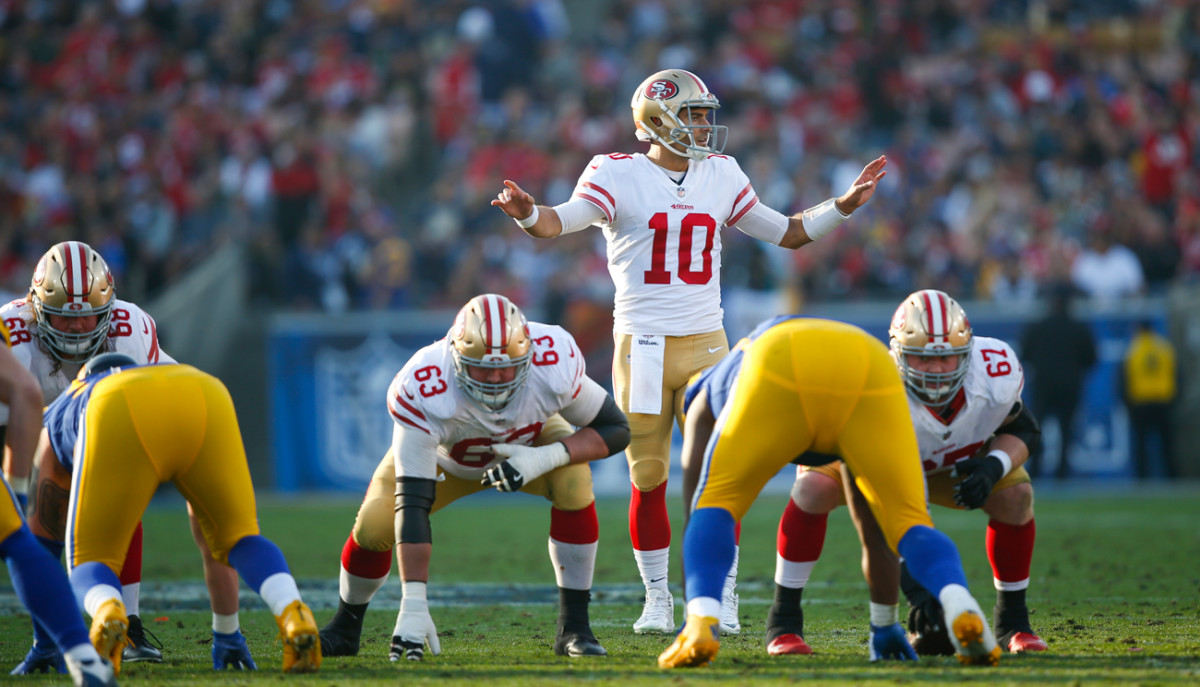Jimmy Garoppolo Takes Charge, Richard Sherman Steps In: 10 Thoughts on the 49ers

With the NFL season just a few weeks away, Andy Benoit is previewing every NFL team in reverse order of last season’s finish. Up today: the San Francisco 49ers, who finished 6–10 in 2017. This is an updated version of a story that originally ran in June for The MMQB's California Week.
1. We don’t know how great Jimmy Garoppolo will be, but it speaks volumes that GM John Lynch, with head coach Kyle Shanahan’s and owner Jed York’s blessings, made him the game’s the highest-paid QB (at the time) after just five starts in San Francisco. Lynch could have franchise-tagged Garoppolo and gotten 16 more games to analyze, but he feared Garoppolo's price tag would skyrocket before then. Talk about faith in your QB.
Here’s what’s to love about Garoppolo: He’s a quick, compact thrower, which lets him get the ball out extra early or extra late in the down. He has the quick feet—and, it appears, toughness—to move within the pocket. When that’s not an option, he's mobile enough to escape. These intriguing tools suggest he can clean up his occasional accuracy glitches.

Also to love: Garoppolo’s football IQ. He didn't fully understand Shanahan’s scheme and its terminology when he took the field 34 days after being dealt to San Francisco—no QB could have so quickly. But Garoppolo understood route combinations and basic coverage-beating designs so thoroughly that he could figure things out as he went. Imagine him in 2018, now that he does know Shanahan’s scheme.
2. A defining trait of Shanahan’s scheme: base personnel. Fullback Kyle Juszczyk played 53 percent of the snaps in games that Garoppolo started. A fullback allows you to change the formation’s strength and create new gaps in the run game post-snap. To account for this, the defense must commit a safety to the box, which renders its coverages predictable. Those predictable coverages are a big reason why Shanahan throws the ball so often out of base personnel. The other reason is matchup problems. Shanahan is shrewd with route combinations that pit receivers against linebackers and safeties. It helps having tailbacks who can catch. Hence the free-agent signing of Jerick McKinnon. The former Viking backup/fringe starter isn't worth $30 million over four years in most schemes, but he is in this one.
3. Another defining trait of Shanahan’s scheme is pre-snap motion, especially involving backs and tight ends. Among other benefits, pre-snap motion forces the defense to reveal its coverage, which helps the QB play fast.
4. Ineptitude along the interior O-line, particularly early in the season, was the 49ers’ biggest problem in 2017. In response, they traded for former Lions first-round guard Laken Tomlinson last August. More importantly, they signed former Giants center Weston Richburg in March. If 2016 first-rounder Josh Garnett can return from his troubling knee injury, it’s an all-new interior, with a new first-round tackle, Mike McGlinchey, to boot. Richburg was an effective north-south blocker in New York, and Garnett’s fundamental pull-blocking shined on film his rookie year. Let’s assume both can generate the lateral mobility Shanahan’s zone-blocking scheme demands. The question becomes Tomlinson, who is more of a mauler than a maneuverer. The O-line’s mobility and continuity will determine the efficacy of the play-action game, which is the last defining trait of Shanahan’s scheme.
5. Marquise Goodwin is not quite a true No. 1 receiver, but he became much more than just a speedster last year, particularly once Garoppolo stepped in. With Goodwin and Pierre Garçon outside, and Trent Taylor and second-round rookie Dante Pettis inside, San Francisco’s receiving corps can be good enough.
6. Defensive coordinator Robert Saleh subscribes to the Pete Carroll/Gus Bradley/Dan Quinn Cover 3 system, but what differentiates Saleh is his willingness to deviate from it. He shows multiple looks, including pressure packages, early in the game, and mixes in different zone coverages throughout. He’ll do it just enough that quarterbacks must always take the time to verify the coverage after the snap.
7. In Saleh’s scheme, the most critical position up front is the 3-technique. That job belongs to third-year sensation DeForest Buckner, who will be a dark horse for Defensive Player of the Year.
“A Bit of Brady”: How Jimmy Garoppolo Copied the G.O.A.T.—Then Escaped His Shadow
8. The lack of a true edge rusher is a real concern, especially in such a classic one-deep safety scheme. Buckner and Solomon Thomas make the Niners’ nickel pass rush potentially formidable inside, but if Arik Armstead does not emerge outside, this D has little chance of constricting the pocket. Armstead is long and talented, but he’s not a pure 4-3 end.
9. It was a tumultuous offseason for Reuben Foster, to say the least. The 49ers were willing to let the legal system play out because, well, name one team that would cut a player who just a year earlier was one of the top three players on its draft board. Foster’s talent jumps out on film. There’s an easiness to his movement and a sturdiness to his strength. Given his proficiency in coverage at Alabama, he has a chance to be a premium three-down NFL linebacker.
10. A lot rides on Richard Sherman. Other than Ahkello Witherspoon, who showed flashes of intrigue as a third-round rookie last year, the Niners have no proven entities at outside cornerback (assuming Jimmie Ward stays at free safety). Sherman is only 30, which isn’t old for a player whose game does not rely on speed and quickness, but he’s coming off surgeries on both Achilles. That’s not what any defense, and especially one that lacks edge rushers and all-around depth, wants to count on.
BOTTOM LINE: The Kyle Shanahan—Jimmy Garoppolo marriage can lift an otherwise developing offense and intriguing but still work-in-progress defense.
• Question or comment? Email us at talkback@themmqb.com.
